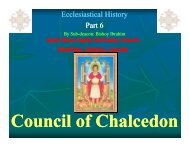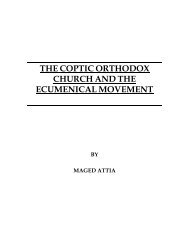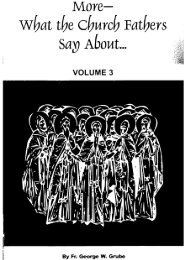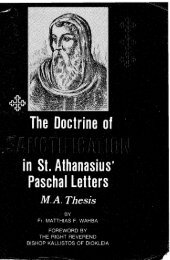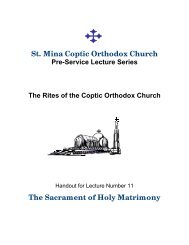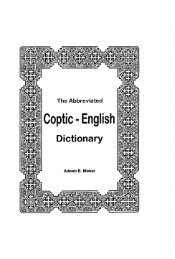Coptic interpretations of the Fourth Ecumenical Council - Saint Mina ...
Coptic interpretations of the Fourth Ecumenical Council - Saint Mina ...
Coptic interpretations of the Fourth Ecumenical Council - Saint Mina ...
You also want an ePaper? Increase the reach of your titles
YUMPU automatically turns print PDFs into web optimized ePapers that Google loves.
toge<strong>the</strong>r coming to a clear understanding that both families have always<br />
loyally maintained <strong>the</strong> same au<strong>the</strong>ntic Orthodox Christological faith, and <strong>the</strong><br />
unbroken continuity <strong>of</strong> <strong>the</strong> apostolic tradition, though <strong>the</strong>y may have used<br />
Christological terms in different ways. It is this common faith and continuous<br />
loyality to <strong>the</strong> apostolic tradition that has been <strong>the</strong> basis <strong>of</strong> <strong>the</strong><br />
conversations held over <strong>the</strong> last two decades towards unity and communion.<br />
In 1964 a fresh dialogue began at <strong>the</strong> University <strong>of</strong> Aarhus in Denmark. This<br />
was followed by meetings at Bristol in 1967, Geneva in 1970 and Addis Ababa in<br />
1971. These were a series <strong>of</strong> non-<strong>of</strong>ficial consultations which served as steps<br />
towards mutual understanding.<br />
The <strong>of</strong>ficial consultations in which concrete steps were taken began in 1985 at<br />
Chambesy in Geneva. The second <strong>of</strong>ficial consultation was held at <strong>the</strong> monastery<br />
<strong>of</strong> <strong>Saint</strong> Bishoy in Wadi-El-Natroun, Egypt in June 1989. The outcome <strong>of</strong> this<br />
latter meeting was <strong>of</strong> historical dimensions, since in this meeting <strong>the</strong> two<br />
families <strong>of</strong> Orthodoxy were able to agree on a Christological formula, thus<br />
ending <strong>the</strong> controversy regarding Christology which had lasted for more than<br />
fifteen centuries.<br />
In September 1990, <strong>the</strong> two families <strong>of</strong> Orthodoxy signed an agreement on<br />
Christology and recommendations were passed to <strong>the</strong> different Orthodox<br />
Churches, to lift <strong>the</strong> ana<strong>the</strong>mas and enmity <strong>of</strong> <strong>the</strong> past, after revising <strong>the</strong><br />
results <strong>of</strong> <strong>the</strong> dialogues. If both agreements are accepted by <strong>the</strong> various<br />
Orthodox Churches, <strong>the</strong> restoration <strong>of</strong> communion will be very easy at all<br />
levels, even as far as sharing one table in <strong>the</strong> Eucharist.<br />
''As for its part, <strong>the</strong> <strong>Coptic</strong> Orthodox Church has agreed to lift <strong>the</strong><br />
ana<strong>the</strong>mas, but this will not take place unless it is performed bilaterally,<br />
possibly by holding a joint ceremony.'' (H.E. Metropolitan Bishoy,<br />
Metropolitan <strong>of</strong> Damiette and Secretary <strong>of</strong> <strong>the</strong> Holy Synod, <strong>Coptic</strong> Orthodox<br />
Church, and Co-chairman <strong>of</strong> <strong>the</strong> Joint Commission <strong>of</strong> <strong>the</strong> Official Dialogue,<br />
El-Kerasa English Magazine, May 1992, Vol. 1, No. 1, p. 8).<br />
3. SYNOPSIS<br />
AARHUS 196 4<br />
+ Over 3 days, 15 <strong>the</strong>ologians from both families met in Aarhus in Denmark for<br />
informal conversations. They recognised in each o<strong>the</strong>r <strong>the</strong> one orthodox<br />
faith.<br />
+ The well known phrase used by our common fa<strong>the</strong>r, St. Cyril <strong>of</strong> Alexandria<br />
''<strong>the</strong> one nature <strong>of</strong> God's Word Incarnate'' was at <strong>the</strong> centre <strong>of</strong> <strong>the</strong><br />
conversations. Through <strong>the</strong> different terminologies used by each side,<br />
<strong>the</strong>y saw <strong>the</strong> same truth expressed. On <strong>the</strong> essence <strong>of</strong> <strong>the</strong> Christological<br />
dogma <strong>the</strong>y found <strong>the</strong>mselves in full agreement.<br />
+ As for <strong>the</strong> <strong>Council</strong> <strong>of</strong> Chalcedon (451) both families agreed without<br />
reservation on rejecting <strong>the</strong> teaching <strong>of</strong> Eutyches as well as Nestorius, and<br />
thus <strong>the</strong> acceptance or non-acceptance <strong>of</strong> <strong>the</strong> <strong>Council</strong> <strong>of</strong> Chalcedon does not<br />
entail <strong>the</strong> acceptance <strong>of</strong> ei<strong>the</strong>r heresy.<br />
+ It was agreed that <strong>the</strong> significant role <strong>of</strong> political, sociological and<br />
cultural factors in creating tension between factions in <strong>the</strong> last fifteen<br />
centuries should be recognized and studied toge<strong>the</strong>r. They should not,<br />
however, continue to divide us.<br />
BRISTOL 1967<br />
The Agreed Statement from <strong>the</strong> second informal conversations in Bristol,<br />
England, firstly affirmed new areas <strong>of</strong> agreement and <strong>the</strong>n discussed <strong>the</strong><br />
questions that still remained to be studied and settled.<br />
— ONE —<br />
+ Based on <strong>the</strong> teachings <strong>of</strong> common fa<strong>the</strong>rs <strong>of</strong> <strong>the</strong> universal Church <strong>the</strong>y<br />
approached <strong>the</strong> Christological question from <strong>the</strong> perspective <strong>of</strong> salvation.<br />
2



